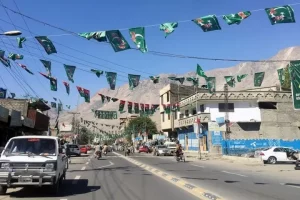Even as Imran Khan tries to score some brownie points by approving a plan to build the first temple in capital Islamabad, mass conversion of Hindus and atrocities against the minority community continue to take place all over Pakistan.
A video went viral on social media Sunday claiming that as many as 102 Hindus have been converted to Islam and a mandir (temple) converted to a masjid (mosque) in Golarchi, Sindh.
<blockquote class="twitter-tweet">
<p dir="ltr" lang="en">102 Hindu Men, Women and children are converted to Islam in Golarchi, District Badin, Sindh-<a href="https://twitter.com/hashtag/Pakistan?src=hash&ref_src=twsrc%5Etfw">#Pakistan</a>. All idols of <a href="https://twitter.com/hashtag/Hindu?src=hash&ref_src=twsrc%5Etfw">#Hindu</a> Gods are destroyed in local temple and now Hindu Temple is converted into a mosque. <a href="https://t.co/iPKsb2p1nz">https://t.co/iPKsb2p1nz</a> <a href="https://t.co/zPbRVXW0Eh">pic.twitter.com/zPbRVXW0Eh</a></p>
— Voice of Kashmir(Humara)? (@Humarayousaf_) <a href="https://twitter.com/Humarayousaf_/status/1277276118114918401?ref_src=twsrc%5Etfw">June 28, 2020</a></blockquote>
<script async src="https://platform.twitter.com/widgets.js" charset="utf-8"></script>
The region which has a sizeable population of Hindus—the 1998 census reported approximately 6.5 per cent of Sindhi population to be Hindu—has witnessed mass conversions, particularly targeting the local Bheel community, in the last many decades.
A report 'Forced conversion of minority girls and women in Pakistan,' which was jointly submitted by the World Sindhi Congress (WSC) and the Unrepresented Nations and Peoples Organization (UNPO) to the UN Office of the High Commissioner for Human Rights a few years ago, had highlighted the plight of Hindu minority community living in Sindh in detail.
It mentioned how the Hindu minority is particularly affected by oppressive national laws and discrimination in Pakistan, including the blasphemy laws which reveal the level of institutionalization of discrimination in the country.
"As intolerance towards religious minorities grows in Pakistan, so does the practice of forced conversions. As indicated by the former vice-chairperson of the Human Rights Commission of Pakistan (HRCP), Amarnath Motumal, 20 or more Hindu girls are abducted and converted every month in Pakistan… The most vulnerable areas for forced conversions in Sindh are the Thar region (Umerkot, Tharparkar and Mirpur Khas districts), Sanghar, Ghotki, and Jacobabad," the report mentioned.
<img class="wp-image-4147 size-medium" src="https://indianarrative.com/wp-content/uploads/2020/06/bf507a116af19838e2717f1b04ea5c06-200×300.jpg" alt="" width="200" height="300" /> Scene from a protest rally held by the Pakistani Christians to demand the government rebuild their homes after they were burned down following an alleged blasphemy incident in Lahore (Jamil Ahmed/Xinhua/IANS)"While there are different methods used to force people to convert, two common forms in Pakistan are bonded labor and forced marriage. Most bonded laborers in Sindh belong to the Hindu minorities, mainly belonging to the Scheduled Castes. Bonded laborers are enslaved as a result of debts, using their labor as a form of payment and living under surveillance (although there are also cases of individuals who have been enslaved simply due to religious hatred). Working in agriculture, brick kilns, tanning, and carpet industries, they are usually submitted to physical and/or sexual violence. Government officials fail to enforce the national law on Bonded Labour Abolition (1992), while police recurrently fail to register complaints against landowners," it mentioned further.
In another recent video shared by Rahat Austin, a Pakistani lawyer and human rights activist, a Hindu woman is inconsolable, fainting as her 14-year-old daughter is abducted and forcibly converted in Saedabad area of Sindh.
<blockquote class="twitter-tweet">
<p dir="ltr" lang="en">"It is a curse to born in an Islamic County".
Says a Non-Muslim, Hindu mother, while hiting herself with grief, falling unconscious, whose 14-years daughter, Nasiban, is taken for sexual exploitation & forced conversion to Islam in Saedabad,Hala,Mitiari, Sindh-Pakistan.27-6-2020 <a href="https://t.co/h8rdVoXJlX">pic.twitter.com/h8rdVoXJlX</a></p>
— Rahat Austin (@johnaustin47) <a href="https://twitter.com/johnaustin47/status/1276955789861588992?ref_src=twsrc%5Etfw">June 27, 2020</a></blockquote>
<script async src="https://platform.twitter.com/widgets.js" charset="utf-8"></script>
Even though the Council of Islamic Ideology (CII) had in January termed forced conversions as "un-Islamic and unconstitutional" there has been no effort being made by the Pakistani government to curb the menace.
Writing in the <em>The News on Sunday</em>, the weekly magazine of Pakistan's leading daily <em>The News International</em>, Waqar Gillani says: "There has been a clear pattern, girls from religious minority communities are kidnapped and later converted to Islam in areas where said religious minorities comprise a sizable proportion of the population. In Sindh, such cases mostly take place in areas populated by Hindus like Umar Kot, Ghotki and Tharparkar districts. In the Punjab, similar incidents are reported in areas where the Christian community are in sizable numbers. According to a senior resident of Nankana Sahib, a few such cases within the Sikh community have also taken place in the past but remained under-reported in mainstream media. In most of the reported cases, the age of the converted girls is between 18 and 21 years and after alleged ‘elopement’, they convert to Islam and get certification from a religious seminary."
The pattern, the system, the plight of minorities in Pakistan remains the same and, looking at the intent, or the lack of it, shown by the present government, it shall be unchanged in the coming times too..




















